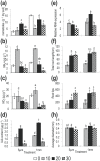Soil Nitrogen Status Modifies Rice Root Response to Nematode-Bacteria Interactions in the Rhizosphere
- PMID: 26841062
- PMCID: PMC4739600
- DOI: 10.1371/journal.pone.0148021
Soil Nitrogen Status Modifies Rice Root Response to Nematode-Bacteria Interactions in the Rhizosphere
Abstract
It has been hypothesized that faunal activity in the rhizosphere influences root growth via an auxin-dependent pathway. In this study, two methods were used to adjust nematode and bacterial populations within experimental soils. One is "exclusion", where soil mixed with pig manure was placed in two bags with different mesh sizes (1mm and 5μm diameter), and then surrounded by an outer layer of unamended soil resulting in soil with a greater populations of bacterial-feeding nematodes (1mm) and a control treatment (5μm). The second method is "inoculation", whereby autoclaved soil was inoculated with bacteria (E. coli and Pseudomonas) and Nematodes (Cephalobus and C. elegans). In order to detect the changes in the rice's perception of auxin under different nutrient and auxin conditions in the presence of soil bacterial-feeding nematodes, responses of soil chemistry (NH4+, NO3- and indole acetic acid (IAA)), rice root growth and the expression of an auxin responsive gene GH3-2 were measured. Results showed that, under low soil nutrient conditions (exclusion), low NO3- correlated with increased root branching and IAA correlated with increased root elongation and GH3-2 expression. However, under high soil nutrient conditions (inoculation), a high NH4+ to NO3- ratio promoted an increase in root surface area and there was an additional influence of NH4+ and NO3- on GH3-2 expression. Thus it was concluded that soil bacterial-feeding nematodes influenced soil nutritional status and soil IAA content, promoting root growth via an auxin dependent pathway that was offset by soil nitrogen status.
Conflict of interest statement
Figures





References
-
- Malamy JE. Intrinsic and environmental response pathways that regulate root system architecture. Plant Cell Environ. 2005; 28: 67–77. - PubMed
-
- Cadet P, Guichaoua L, Spaull VW. Nematodes, bacterial activity, soil characteristics and plant growth associated with termitaria in a sugarcane field in South Africa. Appl Soil Ecol. 2004; 25: 193–206.
Publication types
MeSH terms
Substances
LinkOut - more resources
Full Text Sources
Other Literature Sources

